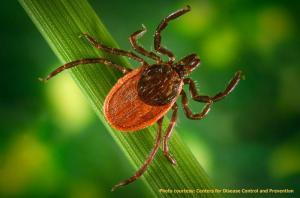What You Should Know About Ticks
- posted: Aug. 06, 2017
 Tick-borne illnesses in Dogs in York County
Tick-borne illnesses in Dogs in York County
Ticks are external parasites in the arachnid family which also includes spiders and mites. There are multiple species of ticks. The most common in our area are the brown dog tick and the deer tick. Ticks live primarily in wooded areas in the tall grass. They do not actually live in or fall from trees. A tick will sit on the tip of a blade of grass and grab onto passing animals or people. Once on board, they find an area to bite and attach to the skin so they can feed on blood. Ticks may attach and feed for a period of several hours to several days after which they detach and fall off in search of a new host.
As I am sure many of you know ticks carry a variety of diseases including Lyme disease as well as illnesses like ehrlichia and anaplasma. Cats are not susceptible to these diseases, but dogs are. These bacteria are carried by ticks and injected into the bloodstream when the tick bites. York County has a high incidence of Lyme disease—more than 5,000 cases are diagnosed in dogs annually. Nearly 400 cases of anaplasmosis and 200 cases of ehrlichia have been found in York. All three diseases can cause similar symptoms of fever, lethargy, loss of appetite and stiff, sore joints. Ehrlichiosis and Anaplasmosis can also cause problems with platelets, affecting blood clotting and leading to bruising and bleeding. Some dogs can also develop severe kidney disease secondary to Lyme disease. Fortunately, most pets have no symptoms at all or only minor symptoms and, if they are symptomatic, most will recover if treated with antibiotics.
How can you protect your pets against ticks? If you walk in York County parks or live in a wooded area, check your pets daily for ticks and remove any found promptly. Use of appropriate tick preventatives can also help to reduce the chance of ticks biting and spreading disease. Patton Veterinary Hospital carries several brands of effective flea and tick preventatives. Some are topical (placed on the skin) and some are chewable. Vaccinations are also available to protect your dog against Lyme disease for those in high risk areas and situations.
If a tick has become attached to your pet, remove it quickly but be sure to remove it correctly. Grasp the tick with a tissue or paper towels (avoid grabbing with bare fingers) or with tweezers and pull straight out. Do not try to burn the tick or apply any chemicals to it. If the head breaks off, do not panic. If you can remove the head, try to do so, but, if it is deeply embedded or attempting to remove it is causing the skin to turn red or bleed, stop. The head will work its way out like a splinter and continuing to try to remove it will only cause discomfort and possible infection.
So, remember to protect your dogs from ticks by doing daily checks, using good, effective flea and tick preventatives and vaccinating your dog if he is at high risk.
This blog brought to you by the Patton Veterinary Hospital serving Red Lion, York and the surrounding communities.
Source: www.dogsandticks.com
Location
Patton Veterinary Hospital
425 E Broadway
Red Lion, PA 17356
